
I'm a novice when it comes to big international art exhibitions, but like all bloggers who've been to Documenta XII, I feel compelled to make a report.
>>read the report (with pictures)>>
|
I thought Documenta was great. I disagree with Jerry Saltz, who described the curation as "arrogant and dogmatic" and I agree with Corinna Ghaznavi, who said,
"[The curators'] aims - to focus less on representation and more towards production, to strengthen the spectatorial experience, to curate and install works such that we can 're-think the terms that guide us through the present'- were all realized in this vast and beautiful exhibition."

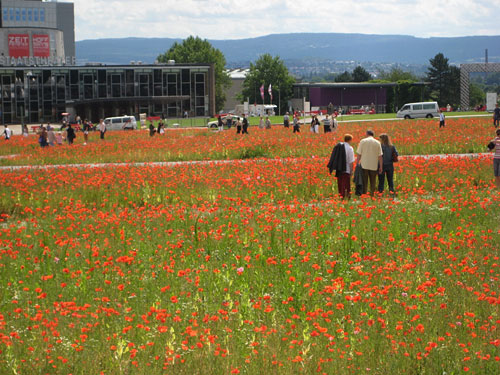
Sanja Iveković's Poppy Field (photos by me)
Ghaznavi also mentions a sensen of "quietude" in the show, which jives comepletely with my experience. I began my first day in a sort of fevered state of resolve to take in as much as I could as fast as I could. But that sense of task-completion dissolved immediately when I approached the Documenta HQ in Kassel's expansive Friedrichplatz. Sanja Iveković's Poppy Field was a glowing sea of red, a visual spectacle that made me plop right down on a bench and take a deep breath. As I thought about poppies, and discarded "Flanders Fields" as an unlikely reference, I began to take in the intermittent audio broadcasts of revoluntionary songs by Afghan women, singing out over this historic parade ground in one of Germany's most historic military towns.
Are all international shows this site specific? I doubt it. In the context of Germany's remarkable culture—with it's refusal to turn a blind eye on horror, and it's determination to move forward nonetheless—the dynamic of bringing art together from all over the globe seemed like an urgent cultural necessity rather than a glitzy spectacle. I started to wander through the exhibition, and, being on my own, I felt completely at ease to take in as much or as little of each work that I encountered. There were a few curatorial decisions that really enhanced this open and absorbent frame of mind. For one thing, the massive Aue-Pavillon where I began was laid out generously with plenty of space to wander and multiple paths to follow. Also there were tons of families with their kids, which made it really fun, and for some reason I couldn't fathom it was perfectly okay to take pictures of the art.
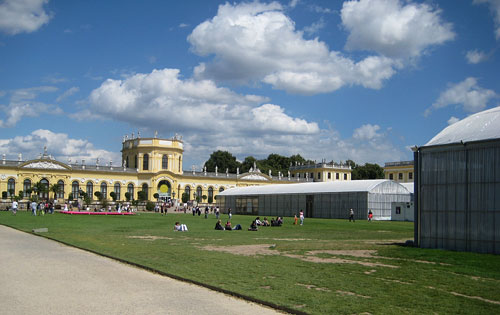
Documenta's Aue-Pavillon, next to the Orangerie (photo by me)
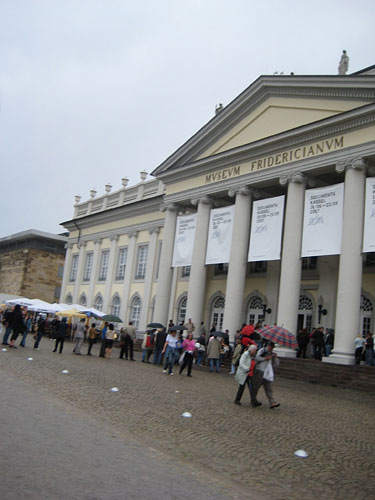
People lining up outside the Museum Fredericianum, which, I found out from the curatorial literature, was the first public museum ever. Like most of Kassel it was destroyed during the war and has been rebuilt. The first ever Documenta was held in the ruins in 1955. (photo by me)
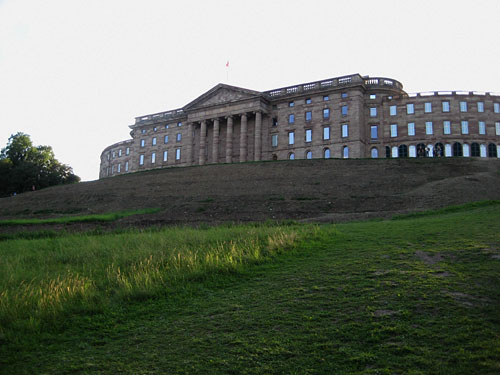
Schloss Wilhelmshöhe, showing the Terraced Rice Fields by Sakarin Krue-On. I almost missed the Documenta installation in this museum because the works were insinuated here and there amongst the impressive collection of grand old paintings and artefacts. (photo by me)
As I continued through the other buildings I began to really appreciate that certain artists works were sprinkled throughout the entire exhibition, notably Kerry James Marshall, Juan Davila, Mary Kelly and Martha Rosler.
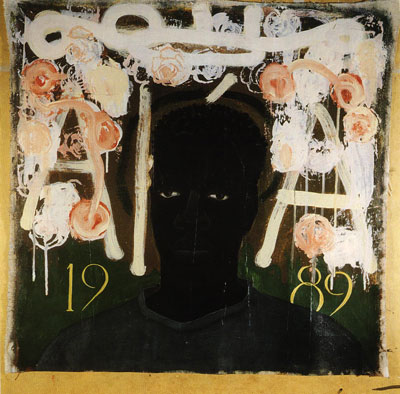
Kerry James Marshall's Lost Boys: AKA Black Al, image borrowed from The University of Virginia ("An Interview With Kerry James Marshall" By Charles Rowell)
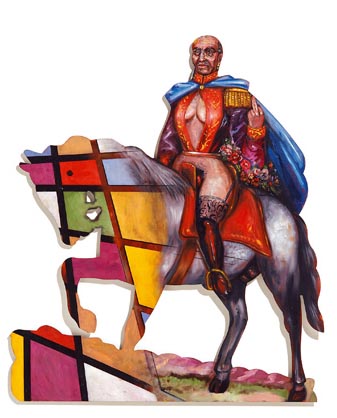
Juan Davila's The Liberator Simon Bolivar, image
borrowed from Art Almanac
|
And there was a lot of history popping up here and there as well, some representatives of the nearish past and present such as Romuald Hazoumé's iconic plastic bottle masks, representatives of the foundations of conceptual and performance art such as Atsuko Tanaka's Electric Dress from 1956, and some really really old tapestries and calligraphy from the 14th-16th centuries. The catalogue is organised chronologically, which is disorienting at first but emphasises the fact that this vast display of contemporary work is grounded in the past. Again, an anti-spectacle kind of context, but handled with a light touch so that coming across these older gems was a sort of delightful discovery rather than a boring history lesson.
A lot of the work was political and hard-hitting, but at the same time much of the most difficult work operated on an emotive and aesthetic plane rather than a didactic one. There was a lot of sadness, but I never once felt that sense of oppression that can come with looking at too much art about pain and struggle all at once.
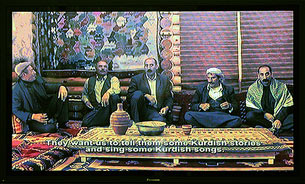 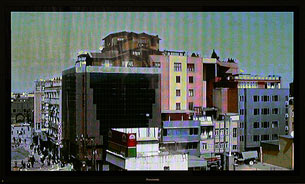
Stills from Halil Altindere's Dengbêjs, borrowed from Universes in Universe
One example is a captivating video by Halil Altindere, Dengbêjs, in which Kurdish men gather in a richly carpeted wooden hut that perches atop a concrete block building in the middle of a major urban centre. The men sit together drinking coffee, fingering beads, and taking turns to sing songs. The songs begin with traditional tales of love and strife and romance, girls and boys finding ways to be together. As each man sings, the songs become increasingly political and contemporary in nature, ending with a rousing and heartwrenching dirge mourning the murders and kidnappings of Kurdish leaders. As each man sings, the others rock and sway along to the song, chiming in occasionally in a group lament or grunting emphasis in places that are particularly poignant. At the end, one of the men goes steps outside for a smoke, and the camera pans away from this intimate scene, framing this charged meeting place in the context of the urban landscape that surrounds it.
Here's a sampling of other works and projects that made an impression on me.
Most Beautiful...
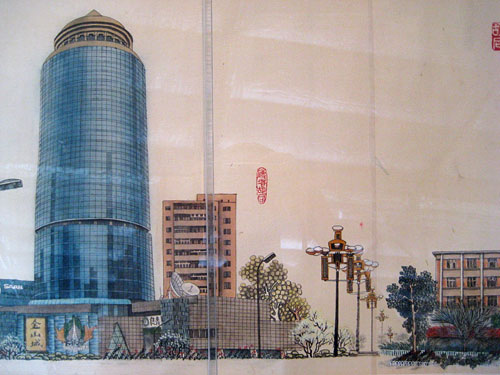
Lu Hao's recording 2006 chang'an street, an utterly staggering spread of silk scrolls with impeccably delicate paintings that document the street in Beijing that Tian'anmen Square is on. Like Sanja Iveković's poppies (also a contender for 'most beautiful'), seeing this piece alone would have been worth the trip. (photo by me)
Most Charming...
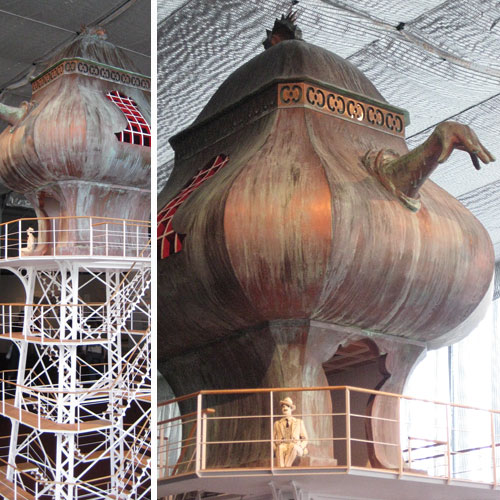
Lukas Duwenhögger's The Celestial Teapot, a proposed monument to the homosexuals persecuted by the Nazi's.Note the cute little death-in-Venice dude perched at the top, and the limp-wrist tea spout. (photos by me)
Most Moving...
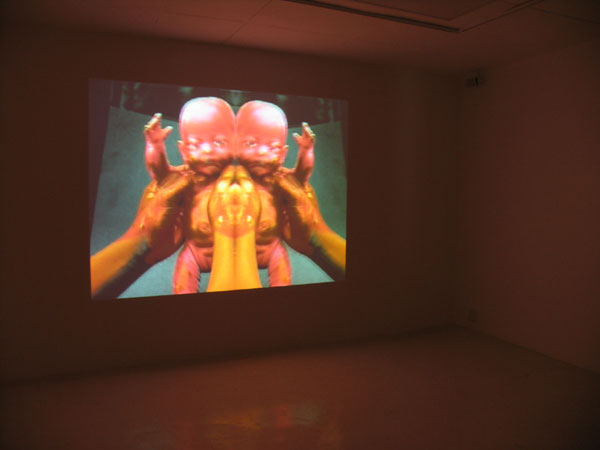
Churchill Madikida's Nemesis, projected with another work, Virus. Both videos are about AIDS. In Nemesis, a man rubs what look likes blood on baby doll. The image is digitally reflected and kaleidoscoped, turning the image of the bloody morphing baby into a demonic yet beautiful monster. (image borrowed from Michael Stevenson)
Most Fun...
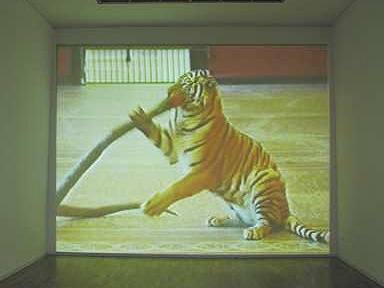
Peter Friedl's video Tiger oder Löwe in which a tiger wrestled a stuffed snake in the Hamburg Kunsthalle. His badly taxidermied giraffe was pretty funny too, but I think my favourite piece of his was the installation of his own childhood drawings, from 1968. Von Bark and I have been having discussions lately about how so much great art is like kid's art, but in fact kid's art itself is really great art! These were in a room adjacent to Annie Pootoogook, which was about the only curatorial decision I questioned. There is a naivete in Pootoogook's drawing style, for sure, but as far as I know she's a fully functioning adult. It made me all warm-fuzzy Canada proud to see her work in this context. (image borrowed from Hamburger Kunsthalle)
Most Proud Making...
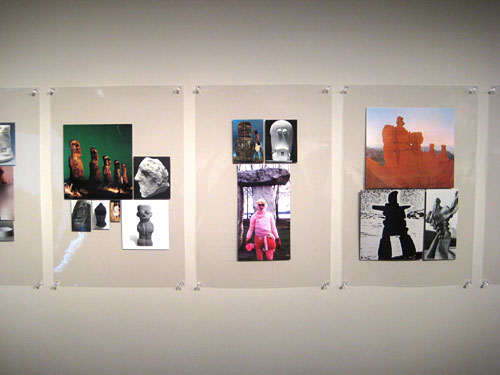
Luis Jacob's Album III really shone. A vast array of seemingly random clippings, organised in a linear narrative so that each picture is related either visually or conceptually to its surrounding fellows. The story is epic, starting with facism, passing through modernism, and many many other themes, ending with dance and physical freedom. And, in the middle of it all... an old Lola cover featuring Sandy Plotnikoff! I snapped this little keepsake photo, but I couldn't get a really nice shot because the room was packed and hot and the people next to me were literally poking me to make me keep moving.
Most Creepy...

Tseng Yu-Chin's Who's Listening? No.1 in which a series of young kids stand facing the camera, one after the other, obviously instructed not to laugh, while someone splats something milky (yogurt?) onto their faces. It's funny as hell, cause the kids are trying really hard not to crack up and they're obviously having fun. But the money-shot reference is front and centre. The same artist has another piece in the show, Who's Listening? No.5 in which a woman tickles a young boy (it seems like her son) and tries to kiss his feet, saying over and over "your feet smell so pretty, let me kiss them" while he giggles and struggles and protests. The implicatioins of abuse of power are very strong, yet the kids in the scenes are relaxed and enjoying themselves. I will have to find out more about Tseng Yu-Chin because I can't get his videos out of my head. Interestingly the catalogue text makes no mention of child abuse whatsoever.
Most Popular With My Friends..
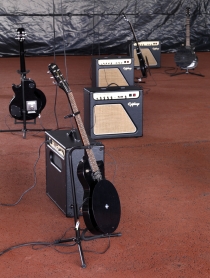
Saâdane Afif's Black Chords plays Lyrics. Being kind of lame when it comes to music I sailed past this vast array of shiny guitars with robotic strummers attached that were droning out various chords. But when I was there on the second day with Von Bark and Frank and Zeina they each chose it unequivocally as their pick for "Best in Show." I didn't find this out til we were all done, drinking yummy German beer and eating about 17 different kinds of meat off one plate, so I never took a good look at it myself. (image borrowed from Documenta)
Note: there is a pretty good photo tour of Documenta XII here
Another Note: we also went to Münster for the Sculpture Project. It was really fun. In an earlier post I included a picture of Rebecca Horn's piece from 1987 which made a huge impact on me and was a great thing to see on my first day ever in Germany. Mike Kelly's petting zoo with Lot's wife salt-lick was clever but didn't blow us away. We didn't get to see some of the best work, which was situated way down the lake, because a big rainy wind storm came up and intimidated us. But we liked the town, especially the promenade where the old city wall used to be, and we spent quite a bit of time (indoors) looking at the old cathedrals and listening to the amazing carillions.
|
http://www.universes-in-universe.de/car/documenta/eng/2007/tour/aue-pavillon/img-11-3.htm
here is a picture of the lu hao, which reminds me of architectural renderings, and also i think is fascinating for its lack of people, and how the use of material and form historicises the very new. the subsumed politics attached to a Chinese way of making western derived building structures is splintered by the capital creation and democratic instincts of what happened there a decade ago, and maybe also the olympics?
i think its a really amazing peice.
that was me
you said it Anthony!
i am glad you could parse that, it was a little dense.
I wish I could find better images of Churchill Madikida's Nemesis. It was really effective. Anthony, I think you'd love it. There is a not bad string of stills here. There are some gorgeous prints from the companion piece,Virus, here that give a sense of the colour saturation and digital aesthetic.
When is Documenta going to show artists who are mental patients.We have been waiting since 1977..ron giii
Ron, on the international circuit, one's mental illness should unfold as a pleasant surprise to everyone around them.
I was wondering the same thing. But then I wondered: maybe Documenta is already showing artists who are mental patients? It's hard to tell who is a mental patient and who isn't if there's no "outsider" art umbrella contextualizing the work in that direction.
|
I'm a novice when it comes to big international art exhibitions, but like all bloggers who've been to Documenta XII, I feel compelled to make a report.
>>read the report (with pictures)>>
- sally mckay 8-27-2007 1:40 am
Sanja Iveković's Poppy Field (photos by me)
Ghaznavi also mentions a sensen of "quietude" in the show, which jives comepletely with my experience. I began my first day in a sort of fevered state of resolve to take in as much as I could as fast as I could. But that sense of task-completion dissolved immediately when I approached the Documenta HQ in Kassel's expansive Friedrichplatz. Sanja Iveković's Poppy Field was a glowing sea of red, a visual spectacle that made me plop right down on a bench and take a deep breath. As I thought about poppies, and discarded "Flanders Fields" as an unlikely reference, I began to take in the intermittent audio broadcasts of revoluntionary songs by Afghan women, singing out over this historic parade ground in one of Germany's most historic military towns.
Are all international shows this site specific? I doubt it. In the context of Germany's remarkable culture—with it's refusal to turn a blind eye on horror, and it's determination to move forward nonetheless—the dynamic of bringing art together from all over the globe seemed like an urgent cultural necessity rather than a glitzy spectacle. I started to wander through the exhibition, and, being on my own, I felt completely at ease to take in as much or as little of each work that I encountered. There were a few curatorial decisions that really enhanced this open and absorbent frame of mind. For one thing, the massive Aue-Pavillon where I began was laid out generously with plenty of space to wander and multiple paths to follow. Also there were tons of families with their kids, which made it really fun, and for some reason I couldn't fathom it was perfectly okay to take pictures of the art.
Documenta's Aue-Pavillon, next to the Orangerie (photo by me)
People lining up outside the Museum Fredericianum, which, I found out from the curatorial literature, was the first public museum ever. Like most of Kassel it was destroyed during the war and has been rebuilt. The first ever Documenta was held in the ruins in 1955. (photo by me)
Schloss Wilhelmshöhe, showing the Terraced Rice Fields by Sakarin Krue-On. I almost missed the Documenta installation in this museum because the works were insinuated here and there amongst the impressive collection of grand old paintings and artefacts. (photo by me)
As I continued through the other buildings I began to really appreciate that certain artists works were sprinkled throughout the entire exhibition, notably Kerry James Marshall, Juan Davila, Mary Kelly and Martha Rosler.
Kerry James Marshall's Lost Boys: AKA Black Al, image borrowed from The University of Virginia ("An Interview With Kerry James Marshall" By Charles Rowell)
Juan Davila's The Liberator Simon Bolivar, image
borrowed from Art Almanac
And there was a lot of history popping up here and there as well, some representatives of the nearish past and present such as Romuald Hazoumé's iconic plastic bottle masks, representatives of the foundations of conceptual and performance art such as Atsuko Tanaka's Electric Dress from 1956, and some really really old tapestries and calligraphy from the 14th-16th centuries. The catalogue is organised chronologically, which is disorienting at first but emphasises the fact that this vast display of contemporary work is grounded in the past. Again, an anti-spectacle kind of context, but handled with a light touch so that coming across these older gems was a sort of delightful discovery rather than a boring history lesson.
A lot of the work was political and hard-hitting, but at the same time much of the most difficult work operated on an emotive and aesthetic plane rather than a didactic one. There was a lot of sadness, but I never once felt that sense of oppression that can come with looking at too much art about pain and struggle all at once.
Stills from Halil Altindere's Dengbêjs, borrowed from Universes in Universe
One example is a captivating video by Halil Altindere, Dengbêjs, in which Kurdish men gather in a richly carpeted wooden hut that perches atop a concrete block building in the middle of a major urban centre. The men sit together drinking coffee, fingering beads, and taking turns to sing songs. The songs begin with traditional tales of love and strife and romance, girls and boys finding ways to be together. As each man sings, the songs become increasingly political and contemporary in nature, ending with a rousing and heartwrenching dirge mourning the murders and kidnappings of Kurdish leaders. As each man sings, the others rock and sway along to the song, chiming in occasionally in a group lament or grunting emphasis in places that are particularly poignant. At the end, one of the men goes steps outside for a smoke, and the camera pans away from this intimate scene, framing this charged meeting place in the context of the urban landscape that surrounds it.
Here's a sampling of other works and projects that made an impression on me.
Most Beautiful...
Lu Hao's recording 2006 chang'an street, an utterly staggering spread of silk scrolls with impeccably delicate paintings that document the street in Beijing that Tian'anmen Square is on. Like Sanja Iveković's poppies (also a contender for 'most beautiful'), seeing this piece alone would have been worth the trip. (photo by me)
Most Charming...
Lukas Duwenhögger's The Celestial Teapot, a proposed monument to the homosexuals persecuted by the Nazi's.Note the cute little death-in-Venice dude perched at the top, and the limp-wrist tea spout. (photos by me)
Most Moving...
Churchill Madikida's Nemesis, projected with another work, Virus. Both videos are about AIDS. In Nemesis, a man rubs what look likes blood on baby doll. The image is digitally reflected and kaleidoscoped, turning the image of the bloody morphing baby into a demonic yet beautiful monster. (image borrowed from Michael Stevenson)
Most Fun...
Peter Friedl's video Tiger oder Löwe in which a tiger wrestled a stuffed snake in the Hamburg Kunsthalle. His badly taxidermied giraffe was pretty funny too, but I think my favourite piece of his was the installation of his own childhood drawings, from 1968. Von Bark and I have been having discussions lately about how so much great art is like kid's art, but in fact kid's art itself is really great art! These were in a room adjacent to Annie Pootoogook, which was about the only curatorial decision I questioned. There is a naivete in Pootoogook's drawing style, for sure, but as far as I know she's a fully functioning adult. It made me all warm-fuzzy Canada proud to see her work in this context. (image borrowed from Hamburger Kunsthalle)
Most Proud Making...
Luis Jacob's Album III really shone. A vast array of seemingly random clippings, organised in a linear narrative so that each picture is related either visually or conceptually to its surrounding fellows. The story is epic, starting with facism, passing through modernism, and many many other themes, ending with dance and physical freedom. And, in the middle of it all... an old Lola cover featuring Sandy Plotnikoff! I snapped this little keepsake photo, but I couldn't get a really nice shot because the room was packed and hot and the people next to me were literally poking me to make me keep moving.
Most Creepy...
Tseng Yu-Chin's Who's Listening? No.1 in which a series of young kids stand facing the camera, one after the other, obviously instructed not to laugh, while someone splats something milky (yogurt?) onto their faces. It's funny as hell, cause the kids are trying really hard not to crack up and they're obviously having fun. But the money-shot reference is front and centre. The same artist has another piece in the show, Who's Listening? No.5 in which a woman tickles a young boy (it seems like her son) and tries to kiss his feet, saying over and over "your feet smell so pretty, let me kiss them" while he giggles and struggles and protests. The implicatioins of abuse of power are very strong, yet the kids in the scenes are relaxed and enjoying themselves. I will have to find out more about Tseng Yu-Chin because I can't get his videos out of my head. Interestingly the catalogue text makes no mention of child abuse whatsoever.
Most Popular With My Friends..
Saâdane Afif's Black Chords plays Lyrics. Being kind of lame when it comes to music I sailed past this vast array of shiny guitars with robotic strummers attached that were droning out various chords. But when I was there on the second day with Von Bark and Frank and Zeina they each chose it unequivocally as their pick for "Best in Show." I didn't find this out til we were all done, drinking yummy German beer and eating about 17 different kinds of meat off one plate, so I never took a good look at it myself. (image borrowed from Documenta)
Note: there is a pretty good photo tour of Documenta XII here
Another Note: we also went to Münster for the Sculpture Project. It was really fun. In an earlier post I included a picture of Rebecca Horn's piece from 1987 which made a huge impact on me and was a great thing to see on my first day ever in Germany. Mike Kelly's petting zoo with Lot's wife salt-lick was clever but didn't blow us away. We didn't get to see some of the best work, which was situated way down the lake, because a big rainy wind storm came up and intimidated us. But we liked the town, especially the promenade where the old city wall used to be, and we spent quite a bit of time (indoors) looking at the old cathedrals and listening to the amazing carillions.
- sally mckay 8-27-2007 1:40 am
http://www.universes-in-universe.de/car/documenta/eng/2007/tour/aue-pavillon/img-11-3.htm
here is a picture of the lu hao, which reminds me of architectural renderings, and also i think is fascinating for its lack of people, and how the use of material and form historicises the very new. the subsumed politics attached to a Chinese way of making western derived building structures is splintered by the capital creation and democratic instincts of what happened there a decade ago, and maybe also the olympics?
i think its a really amazing peice.
- anonymous (guest) 8-27-2007 6:09 am
that was me
- anthony (guest) 8-27-2007 6:11 am
you said it Anthony!
- sally mckay 8-27-2007 7:58 am
i am glad you could parse that, it was a little dense.
- anthony (guest) 8-27-2007 8:46 am
I wish I could find better images of Churchill Madikida's Nemesis. It was really effective. Anthony, I think you'd love it. There is a not bad string of stills here. There are some gorgeous prints from the companion piece,Virus, here that give a sense of the colour saturation and digital aesthetic.
- sally mckay 8-28-2007 7:18 pm
When is Documenta going to show artists who are mental patients.We have been waiting since 1977..ron giii
- giiioriginal@hotmail.com (guest) 9-05-2007 1:58 am
Ron, on the international circuit, one's mental illness should unfold as a pleasant surprise to everyone around them.
- L.M. 9-05-2007 2:10 am
I was wondering the same thing. But then I wondered: maybe Documenta is already showing artists who are mental patients? It's hard to tell who is a mental patient and who isn't if there's no "outsider" art umbrella contextualizing the work in that direction.
- sally mckay 9-05-2007 6:27 am